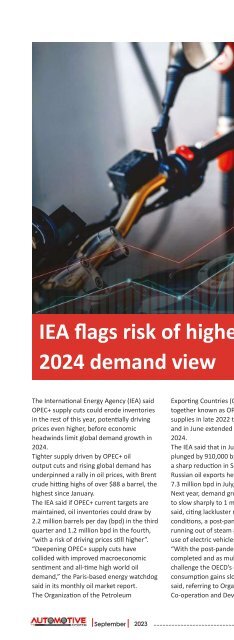Automotive Exports September 2023
Create successful ePaper yourself
Turn your PDF publications into a flip-book with our unique Google optimized e-Paper software.
IEA flags risk of higher oil prices, cuts<br />
2024 demand view<br />
The International Energy Agency (IEA) said<br />
OPEC+ supply cuts could erode inventories<br />
in the rest of this year, potentially driving<br />
prices even higher, before economic<br />
headwinds limit global demand growth in<br />
2024.<br />
Tighter supply driven by OPEC+ oil<br />
output cuts and rising global demand has<br />
underpinned a rally in oil prices, with Brent<br />
crude hitting highs of over $88 a barrel, the<br />
highest since January.<br />
The IEA said if OPEC+ current targets are<br />
maintained, oil inventories could draw by<br />
2.2 million barrels per day (bpd) in the third<br />
quarter and 1.2 million bpd in the fourth,<br />
“with a risk of driving prices still higher”.<br />
“Deepening OPEC+ supply cuts have<br />
collided with improved macroeconomic<br />
sentiment and all-time high world oil<br />
demand,” the Paris-based energy watchdog<br />
said in its monthly oil market report.<br />
The Organization of the Petroleum<br />
Exporting Countries (OPEC) and its allies,<br />
together known as OPEC+, began limiting<br />
supplies in late 2022 to bolster the market<br />
and in June extended supply curbs into<br />
2024.<br />
The IEA said that in July, global oil supply<br />
plunged by 910,000 bpd in part due to<br />
a sharp reduction in Saudi output. But<br />
Russian oil exports held steady at around<br />
7.3 million bpd in July, the IEA said.<br />
Next year, demand growth is forecast<br />
to slow sharply to 1 million bpd, the IEA<br />
said, citing lackluster macroeconomic<br />
conditions, a post-pandemic recovery<br />
running out of steam and the burgeoning<br />
use of electric vehicles.<br />
“With the post-pandemic rebound largely<br />
completed and as multiple headwinds<br />
challenge the OECD’s outlook, oil<br />
consumption gains slow markedly,” the IEA<br />
said, referring to Organisation for Economic<br />
Co-operation and Development nations.<br />
The IEA’s demand growth forecast is down<br />
by 150,000 bpd and contrasts with that of<br />
OPEC, which maintained its forecast that oil<br />
demand will rise by a much stronger 2.25<br />
million bpd in 2024.<br />
“The global economic outlook remains<br />
challenging in the face of soaring interest<br />
rates and tighter bank credit, squeezing<br />
businesses that are already having to cope<br />
with sluggish manufacturing and trade,”<br />
the IEA said. For <strong>2023</strong>, the IEA and OPEC<br />
are less far apart. The IEA expects demand<br />
to expand by 2.2 million bpd in <strong>2023</strong>,<br />
buoyed by summer air travel, increased<br />
oil use in power generation and surging<br />
Chinese petrochemical activity. OPEC sees a<br />
rise of 2.44 million bpd.<br />
Demand is forecast to average 102.2 million<br />
bpd this year, the IEA said, with China<br />
accounting for more than 70% of growth,<br />
despite concerns about the economic<br />
health of the world’s top oil importer.<br />
<strong>September</strong> <strong>2023</strong> 66

















